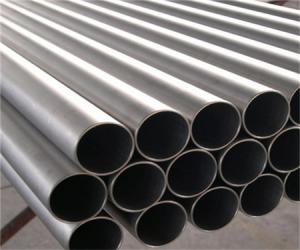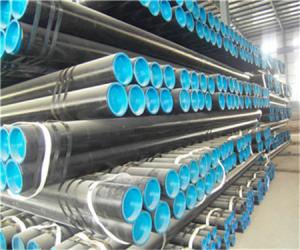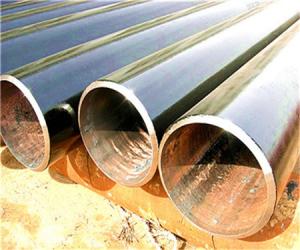Welded 304 Stainless Steel Pipes Manufacturer
- Loading Port:
- China Main Port
- Payment Terms:
- TT or LC
- Min Order Qty:
- 30 kg
- Supply Capability:
- 12000 kg/month
OKorder Service Pledge
OKorder Financial Service
You Might Also Like
Specifications
1、Structure of Seamless Pipe ASTM A106/53 Description:
Seamless pipe is formed by drawing a solid billet over a piercing rod to create the hollow shell. As the manufacturing process does not include any welding, seamless pipes are perceived to be stronger and more reliable. Historically seamless pipe was regarded as withstanding pressure better than other types, and was often more easily available than welded pipe.
2、Main Features of the Seamless Pipe ASTM A106/53:
• High manufacturing accuracy
• High strength
• Small inertia resistance
• Strong heat dissipation ability
• Good visual effect
• Reasonable price
3、Seamless Pipe ASTM A106/53 Specification:
Standard | GB, DIN, ASTM ASTM A106-2006, ASTM A53-2007 |
Grade | 10#-45#, 16Mn 10#, 20#, 45#, 16Mn |
Thickness | 8 - 33 mm |
Section Shape | Round |
Outer Diameter | 133 - 219 mm |
Place of Origin | Shandong, China (Mainland) |
Secondary Or Not | Non-secondary |
Application | Hydraulic Pipe |
Technique | Cold Drawn |
Certification | API |
Surface Treatment | factory state or painted black |
Special Pipe | API Pipe |
Alloy Or Not | Non-alloy |
Length | 5-12M |
Outer Diameter | 21.3-610mm |
Grade | 20#, 45#, Q345, API J55, API K55, API L80, API N80, API P110, A53B |
Standard | ASME, ASTM |
1) Material:20#(ASTM A 106/A53 GRB.API5LGRB,GB),45#,16Mn,10#.
2) Specification range:OD:21.3-610mm,WT:6-70mm,length:6-12m or according to the requirement of clients.
3) Excutive standards:GB,ASME API5L.ASTM A 106/A53,Despite of the above standards,we can also supply seamless steel pipe with standard of DIN,JIS,and so on,and also develop new products according to the requirements of our clients!
4) Surface:black lacquered,varnish coating or galvanized.
5) Ends:Beveled or square cut,plastic capped,painted.
6) Packing:bundles wrapped with strong steel strip,seaworthy packing.
4、Packaging & Delivery
Packaging Details: | seaworthy package,bundles wrapped with strong steel strip |
Delivery Detail: | 15-30days after received 30%TT |
5、FAQ of Seamless Pipe ASTM A106/53:
①How is the quality of your products?
Our products are manufactured strictly according to national and internaional standard, and we take a test
on every pipe before delivered out. If you want see our quality certifications and all kinds of testing report, please just ask us for it.
Guaranteed: If products’ quality don’t accord to discription as we give or the promise before you place order, we promise 100% refund.
②How about price?
Yes, we are factory and be able to give you lowest price below market one, and we have a policy that “ for saving time and absolutely honest business attitude, we quote as lowest as possible for any customer, and discount can be given according to quantity”,if you like bargain and factory price is not low enough as you think, just don’t waste your time.Please trust the quotation we would give you, it is professional one.
③Why should you chose us?
Chose happens because of quality, then price, We can give you both.Additionally, we can also offer professional products inquiry, products knowledge train(for agents), smooth goods delivery, exellent customer solution proposals.Our service formula: good quality+good price+good service=customer’s trust
SGS test is available, customer inspection before shipping is welcome, third party inspection is no problem.
6、Seamless Pipe ASTM A106/53 Images:

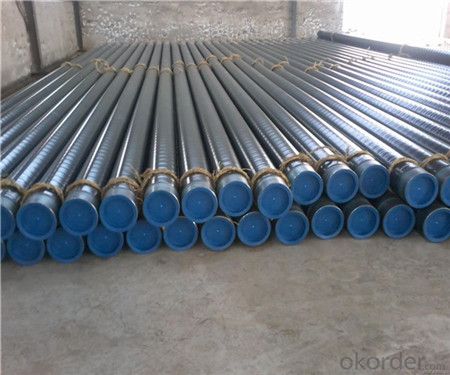
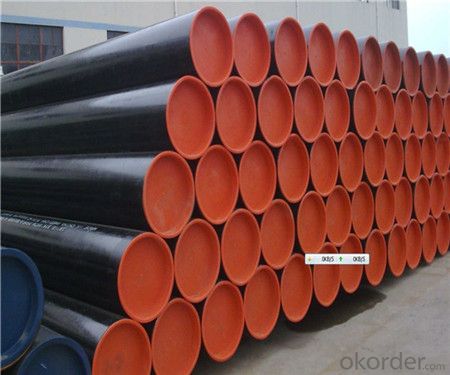
- Q:Why is stainless steel magnetic?
- 304 stainless steel after cold processing, the structure of the structure will also change to martensite, and the greater the deformation degree of cold work, the more martensitic transformation, the greater the magnetic properties of steel. Like a lot of steel strips, the product is made up of 103 tubes, without obvious magnetic induction, producing 9.5 tubes. Due to the large deformation of the Ling bend, the magnetic sense is obvious, and the square tube produced by the utility model has larger deformation than the round tube, especially the folding part, the deformation is more intense, and the magnetism is more obvious. In order to completely eliminate the magnetic properties of the 304 steel caused by the above reasons, the stable austenite structure can be recovered by the solution treatment at high temperature so as to eliminate the magnetism. In particular, magnetic because it causes 304 stainless steel, and other materials such as stainless steel, carbon steel, magnetic 430 is not the same level, that is to say the magnetic steel 304 always showed a weak magnetic.
- Q:Can stainless steel pipes be anodized?
- No, stainless steel pipes cannot be anodized. Anodizing is a process that is typically used on aluminum to create a protective oxide layer on its surface. Stainless steel already has a natural oxide layer, known as a passive layer, which forms spontaneously when exposed to oxygen. This passive layer provides corrosion resistance to stainless steel pipes and does not require anodizing. Therefore, anodizing is not necessary or feasible for stainless steel pipes.
- Q:Can stainless steel pipes be used for underground gas pipelines?
- Indeed, underground gas pipelines can utilize stainless steel pipes due to their remarkable resistance to corrosion. This characteristic renders stainless steel pipes exceptionally suitable for subterranean applications where exposure to moisture, soil, and other corrosive factors is inevitable. Moreover, stainless steel boasts outstanding mechanical properties, such as remarkable tensile strength and durability, which enable it to endure the demanding conditions and pressure prerequisites of gas pipelines below the surface. Furthermore, stainless steel pipes are renowned for their longevity and minimal maintenance needs, resulting in a cost-effective option for underground gas pipelines. Nevertheless, it is imperative to adhere to industry standards and regulations, as well as implement proper installation and maintenance methodologies, to guarantee the secure and efficient operation of gas pipelines.
- Q:What is the maximum temperature stainless steel pipes can handle?
- The specific grade of stainless steel being utilized determines the maximum temperature that can be endured by stainless steel pipes. Generally, stainless steel possesses a reputation for its exceptional resistance to high temperatures and can maintain its structural integrity within a temperature range of -150°C (-238°F) to 1100°C (2012°F). Yet, the precise maximum temperature differs depending on variables including the grade of stainless steel, the intended use, and the length of time exposed to elevated temperatures. To ascertain the maximum temperature limit for a specific stainless steel pipe, it is crucial to refer to the manufacturer's specifications and guidelines.
- Q:Are stainless steel pipes suitable for food storage tanks?
- Yes, stainless steel pipes are highly suitable for food storage tanks. Stainless steel is known for its excellent corrosion resistance, making it ideal for storing food and beverages. Unlike other materials, stainless steel pipes do not leach any harmful substances into the stored food, ensuring its safety and quality. Additionally, stainless steel pipes are easy to clean and maintain, which is crucial for maintaining proper hygiene in food storage tanks. They are also durable and can withstand high temperatures, ensuring the longevity and reliability of the tanks. Overall, stainless steel pipes are the preferred choice for food storage tanks due to their sanitary properties, corrosion resistance, and durability.
- Q:Can stainless steel pipes be used for agricultural irrigation systems?
- Indeed, agricultural irrigation systems can utilize stainless steel pipes. With its exceptional durability and resistance to corrosion, stainless steel proves to be an appropriate material for a wide range of purposes, including agricultural irrigation. Its remarkable ability to withstand rust and corrosion, even when faced with moisture, chemicals, and fertilizers commonly employed in irrigation systems, is well-known. Furthermore, stainless steel pipes possess the capability to endure high-pressure water flow, enabling them to efficiently deliver water to crops. Notably, stainless steel is environmentally conscious, being entirely recyclable, which renders it a sustainable option for agricultural irrigation systems.
- Q:How do you prevent scaling in stainless steel pipes?
- One way to prevent scaling in stainless steel pipes is by using a process called passivation. Passivation involves treating the stainless steel surface with a mild oxidant or acid solution to remove any contaminants and create a protective oxide layer. Regular cleaning and maintenance, avoiding prolonged exposure to high temperatures, and controlling the water chemistry are also effective measures to prevent scaling in stainless steel pipes.
- Q:Can stainless steel pipes be used for geothermal systems?
- Yes, stainless steel pipes can be used for geothermal systems. Stainless steel is highly resistant to corrosion and can withstand the high temperatures and pressures involved in geothermal applications, making it an ideal choice for these systems.
- Q:Are stainless steel pipes suitable for underground heating systems?
- Yes, stainless steel pipes are suitable for underground heating systems. Stainless steel is highly resistant to corrosion, making it ideal for underground applications where pipes are exposed to moisture and other harsh conditions. Additionally, stainless steel pipes have excellent thermal conductivity, ensuring efficient heat transfer throughout the system.
- Q:Can stainless steel pipes be used for both high and low-pressure applications?
- Yes, stainless steel pipes can be used for both high and low-pressure applications. Stainless steel pipes are known for their excellent strength, durability, and corrosion resistance, making them suitable for various pressure conditions. They are commonly used in industries such as oil and gas, chemical processing, and power generation, where both high and low-pressure applications are encountered.
1. Manufacturer Overview |
|
|---|---|
| Location | |
| Year Established | |
| Annual Output Value | |
| Main Markets | |
| Company Certifications | |
2. Manufacturer Certificates |
|
|---|---|
| a) Certification Name | |
| Range | |
| Reference | |
| Validity Period | |
3. Manufacturer Capability |
|
|---|---|
| a)Trade Capacity | |
| Nearest Port | |
| Export Percentage | |
| No.of Employees in Trade Department | |
| Language Spoken: | |
| b)Factory Information | |
| Factory Size: | |
| No. of Production Lines | |
| Contract Manufacturing | |
| Product Price Range | |
Send your message to us
Welded 304 Stainless Steel Pipes Manufacturer
- Loading Port:
- China Main Port
- Payment Terms:
- TT or LC
- Min Order Qty:
- 30 kg
- Supply Capability:
- 12000 kg/month
OKorder Service Pledge
OKorder Financial Service
Similar products
New products
Hot products
Hot Searches
Related keywords
